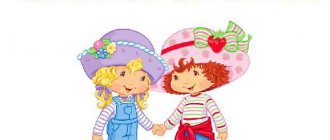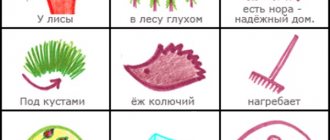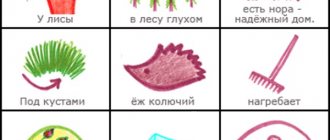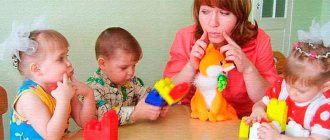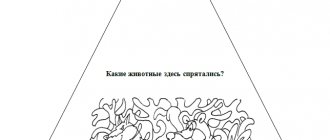Mnemonics for beginners is a system of various methods that helps to remember information using various associations and is used in teaching children from preschool age. This technique uses previously acquired knowledge to create a chain of connections. Thanks to such logical series, you can easily remember information that is difficult to perceive.
There are many mnemonic techniques. For example, Cicero’s method is based on spatial imagination, while Aivazovsky’s method works by training visual memory. Number sequences, foreign words or complex terms are easier to remember with the help of consonant or familiar words and numbers.
In a time when there was no written language, ancient priests and storytellers had to memorize enormous amounts of information. With the advent of the first texts put on paper, the art of using mnemonics did not lose its relevance, because the raw materials for writing them were very expensive. Even in Ancient Greece, notes were made using mnemonics. The art of associative memorization was mastered by the monks of the Middle Ages. At all times, people who could quickly remember and store useful and interesting knowledge in their heads were valued.
How does memory work in preschool children?
Before moving on to a description of the principle of using mnemonic tables, it is necessary to dwell on the features of memory development in preschoolers. First of all, it is important to say that in the majority of preschool children, figurative memory predominates (this can be visual, as well as auditory, olfactory and other images of perception). At the same time, children remember information mainly mechanically, involuntarily. That is, the child remembers what interests him or what makes a strong impression on him. Therefore, an unusual and bright form of presentation is very important. With the development of speech, children's ability to perceive words increases: a preschooler can memorize poetry, he easily remembers the plots of fairy tales and cartoons. However, according to psychological and pedagogical research, it is much easier for children to reproduce information if in the process they can rely on visual diagrams. In older preschool age, the child begins to form voluntary memory. With the development of the ability to self-control, the baby learns to independently remember information that may be useful to him. It is visual aids (diagrams, sketches, notes) that allow children to better remember the necessary material.
Preschool children have the most developed figurative memory, therefore, in order for the child to better remember any information, it is necessary to use various visual aids, including mnemonic tables.
Definition
Mnemonics (mnemonics) is a list of methods and techniques that help remember various types of information.
Mnemonics is based on the principle of visualizing abstract objects, which are replaced by specific concepts or figurative definitions. To easily and quickly memorize the necessary information, you need to associatively associate it with some visual idea, sound image or sensation. Associations - establishing connections with known images and phenomena.
What are mnemonic tables?
Mnemonic tables are diagrams consisting of sequentially arranged image-symbols in which the content of texts (fairy tales, poems, etc.) is encrypted. Thanks to them, the child can perceive information not only auditorily, but also through visual images. The formation of additional associations facilitates the memorization process and helps to reproduce learned material. Most often, mnemonic tables are used for memorizing poems, teaching retelling, composing stories, as well as for memorizing rules and various sequences. But memory development is not the only positive consequence of practicing using mnemonic tables. Children actively develop logic and imaginative thinking, attention, imagination, their vocabulary expands, and beautiful and coherent speech is formed.
It is best to introduce the baby to mnemonics in several stages according to the principle from simple to complex:
- A mnemonic square is a separate card with an object, action or phenomenon schematically depicted on it, in which one word is encrypted (for example, “cup”, “run” or “rain”).
- A mnemonic track is a combination of several linearly arranged mnemonic squares, which can be used to compose a phrase or sentence.
- A mnemonic table is a more complex design consisting of many mnemonic squares, which contains quite a lot of information.
The number of mnemonic squares that make up a track or table depends on the age and other individual characteristics of the child. For children 3-5 years old, small patterns containing 4-8 cells are suitable. With older preschoolers 5-7 years old, you can use tables of 8-16 squares. Mnemonic tables for children must be colorful and bright, so it will be easier for the child to concentrate his attention. For older children, black and white pictures are also suitable. It is important that the images are familiar and understandable to the baby.
When working with mnemonic tables, both hemispheres of the child’s brain are involved: the left, which is responsible for logic and sequential analysis of information, and the right, which is responsible for imaginative thinking and imagination.
Mnemonics for kids: games for memory and speech development (with links to download material)
I started writing a post about our games for speech development, but it turned out to be so huge, and so far it’s such a mess that I decided to write in parts. Today is my post about mnemonics for kids.
Mnemonics
— methods and techniques that facilitate the process of memorizing information. This happens by encoding information into visual, graphic or auditory images. Thus, when working with mnemonic techniques, memory improves, associative thinking is activated and, as for children, speech develops.
There are a huge number of mnemonics developed, in particular, by famous people. For example, Cicero’s method, aimed at spatial imagination (well written about it here), or Aivazovsky’s method, based on visual memory training. A lot of information about all this can be found on the Internet.
Each of us, perhaps without knowing it, is familiar with mnemotechnical techniques. Here, for example, are mnemonic phrases.
Ivan gave birth to a girl, ordered her to drag a diaper (to remember the cases of the Russian language)
Every Hunter Wants to Know Where the Pheasant Sits (to remember the sequence of colors of the rainbow spectrum)
I often use this one: “Dress Nadezhda, put on clothes”
Or, I like it: Dear Hokkaido! I love you Khonshu. For your Shikoku, I give you Kyushu - to remember the four main islands of Japan.
So, I got carried away, I can continue ad infinitum). Stop. Now about the children.
Here I will write about mnemonic games with PICTURES. I’m sure all children love to look at pictures, which are a great help in developing a child’s speech and expanding his vocabulary. Ushinsky was right when he said: “Teach a child some five words unknown to him, and he will suffer for a long time and in vain over them; But associate twenty of these words with pictures, and the child will learn them on the fly.”
1. The first thing I want to write about is mnemonics
. The idea is simple: a picture is drawn for each word or phrase and the entire text is written down in the form of an illustrated diagram (in scientific language this method is called crocking). Speech therapists suggest starting mnemonic exercises with a child from simple to complex
-Mnemonic squares.
-Mnemonic tracks
-Mnemotables
(I took the example from here)
Ulyasha and I somehow skipped the stage of mnemonic squares and went straight to the tracks and even tables. To begin with, I decided to make mnemonic preparations for the poems known to Ulyana, so that she would understand the “rules of the game.” This is how we play. We read, name the drawn images, then the daughter runs to her bookshelf and looks for a book with this rhyme. We look for the desired page and add a bookmark. That is, a game that even resembles lotto in principle. And here is Ulyasha, passionate about the game
After some time, I’ll cut everything into squares, and Ulyasha will lay out the sequence of the poem. At a later stage, it is expected that the child will draw the images of the verse himself. Mothers who have practiced such games note that the child remembers the poem on the fly. Of course, the process is turned into an exciting game!
Another example of mnemonics are the numerous “ABCs” in verse. We only have Marshak’s “ABC” for now, but I’m not purposefully learning letters with my daughter yet, so that’s enough. And here is 1 of our mnemonic tracks.
Mnemonics are also acrostics, that is, those in which the initial letters of the lines form a word or phrase. But this will be interesting for children who already read.
There are a great many ready-made mnemonic tables on the Internet. For example, here you can download thematic ones.
And here is another example of mnemonics, this time for remembering colors.
Each “colored” image is represented by a picture - a stencil, which we put on a card of the desired color. In the photo we played with “blue” cards. The material can be downloaded here
We also memorize poems by playing with flannelgraph. Ulyana loves, for example, Marshak’s poem “Where the sparrow dined.” I read the verse, pause at the right place, Ulyana looks for the animal, names it and pins it to the board.
Pictures for flannelgraph can be downloaded here
2. Close to mnemonics of stories in pictures
, where pictures are drawn instead of words.
Stories like these can significantly enrich a child's vocabulary. For example, vegetables can be studied by reading a story like this.
There are many ready-made stories on the Internet. For example, here
For Ulyasha, such pictures are still a bit complicated. We started with something simpler. To begin with, I made a preparation for the fairy tale “Ryaba Hen,” which my daughter knows by heart.
And here is another version of our games. I write stories about Ulyanka. At the end, some task is given. It's not very visible in the photo. The picture shows a story about how a mouse, a cat and a dog came to visit Ulyana. Ulyana prepared a treat for everyone. And they also brought Ulyasha a delicious gift. Assignment for my daughter: put some food on a plate, choosing from a variety of cards. That is, it turned out to be a game for distinguishing lexical topics (edible-inedible; food-clothing). And of course, Ulyasha is delighted. What child wouldn't love a story about himself!
Many mothers complain that children do not stop for a long time on page 1 of a book, quickly flipping through everything. Stories like these in pictures teach you to focus on one page. Ulyasha and I “read” by moving our fingers))))
3.Sequence games
. The most mnemonics))) For example, such a picture can often be found in kindergartens.
This makes it easier for kids to remember the dressing algorithm. Many mothers at BB give their children the task of decomposing a sequence. Ulyana and I, for example, recently laid out this sequence
Another good game for determining the sequence is lacing with characters from the fairy tale “Turnip”. And motor skills develop at the same time!!!
4.
There are many games based on mnemonics in the method of
M. Shichida
- Memory Grid. We play in several ways.
1. I lay out the cards in front of my daughter, look at them for a few seconds, turn them over and ask: “Let’s remember where I hid...”. We don’t have photos of the process, but you can see this method in Lisa’s video
2. I lay out the cards, look at them for a few seconds, turn them over, and give out a second set of the same ones. Ulyana puts them on top, looks for a pair blindly, turns them over, checks
3. I draw the pieces of paper into squares, glue the stickers, and let Ulyana look at it for a few seconds. I'm cleaning up. I give out the same piece of paper lined up with squares and a set of the same stickers, and we look for the right house.
I like this version of the game the most.
— Linking memory. I can’t write about this game better than Lisa))) We play the same way as Lisa and Alice
— Photo memory. We show the child the picture for a few seconds, remove it, take out 2 pictures, the same one and one very similar to it. (for example, on one there is a girl with a red bow, on the other with a blue one), the child must point to the one that we showed first. Close to this game are mandalas. We read about this from Lisa. And download the material here and here
5. Ulyana also likes the game “Day-Night”. I lay out the cards in front of her, let’s take a look. Then I say, “Night has come,” and my daughter closes her eyes and covers her face with her hands. At this time I hide one picture. I say: “The sun is out, the day has come, let’s wake up.” Ulyanka opens her eyes and guesses “Who/what is hiding”
6. Games to develop tactile and auditory memory
Tactile balls and noisemakers are popular with Ulyanka. The photo can be seen here at the end of the post.
It's fun to play with the tactile bag. We put different items in a bag. At Mom’s request, the Kid must reach for the object with his hand, guessing it by touch.
Auditory memory can be developed through sound lotto. For example, give your child cards with pictures of animals and find the sounds they make. Turn on one by one, and the baby must find the right card.
Another option for those whose kids love cartoons. We download songs, for example, Winnie the Pooh, Troubadour and Uncle Fyodor's mother. We print out images of the characters. We turn it on one by one, the child selects the picture.
Well, a very complicated version (for older children). We give out portraits of classics (Mozart, Beethoven, etc.), play plays, and the child selects pictures.
At the moment, Ulyasha and I are playing like this. We have a book based on Entin’s poems for cartoons.
I downloaded all these songs. I turn on one at a time, and Ulyanka looks for the page with the desired verse. My daughter really likes it. When we played for the first time, she carried this book to me all day long))) Here is her favorite spread and song)))
By the way, we don’t watch cartoons yet. I can imagine the delight that awaits the child when we start watching them!
I'm finishing up about our games for now))).
For mothers of children older than my Ulyanka, I suggest you look at other interesting games using mnemonics here
And there is also a book by T. Polyanskaya «
Using the mnemonic method in teaching storytelling to preschool children
."
You can download it here
I hope such a long post did not bore you, and maybe it was useful to someone.
Our mnemonic preparations and other materials can be downloaded here
P/S. I see that my post was useful and relevant. Girls, let's join forces and post links to our mnemonics right here, in the comments to the post
. Julia and Lyubov have already done it!
Happy games!
How to create a mnemonic table yourself?
When working with your little one, you can use both ready-made mnemonic tables and ones you make yourself. In order to make a table based on a poem or story, you need:
- Divide the text into fragments (the younger the child, the shorter).
- Draw squares on a piece of paper according to the number of text fragments.
- In each square, depict what is said in the fragment, or what is associated with it. A child of senior preschool age can independently draw pictures for the table.
- If you wish, you can sign the text in each square that you need to remember.
Rules for conducting classes
The process of working and learning with children should be comfortable and beneficial.
- You need to start with simple tasks. First, you can look at cards with single images.
- You should not immediately overload your preschooler; he will quickly get tired and will not absorb the information. You can show no more than two mnemonic tables per day.
- All images of didactic material must be bright and colorful. Children quickly remember colorful images. The grass is green, the carrot is orange, the pine cone is brown, the sea is blue.
- It is worth changing the topic of the lesson every time, otherwise the child will lose interest. Today we are learning poetry. Tomorrow - a fairy tale, wild animals, etc.
- It is important that classes take place only in a playful way.
Examples of mnemonic tables for preschoolers
- Mnemonic tables for learning poems
To make it easier for your child to remember the poem, you can use mnemonic tables:
- Read the poem to your child with expression.
- Then you need to tell your child that now you will learn the verse by heart together. After this, read the text again, but at the same time pay little attention to the table.
- Discuss the content of the poem, its main idea.
- Find out whether all the words and pictures are clear to the child, explain their meaning.
- Read line by line and ask your child to repeat after you, based on the pictures.
- Then the baby can try to recite the poem on his own, looking at the mnemonic table.
You can see an example of memorizing a poem using mnemonic tables in the video:
- Learning to retell and compose a story based on a diagram
Preschool children, although they have a fairly extensive vocabulary, often have difficulty composing stories. Kids are easily distracted, confused, and lose the logic of their thoughts. Mnemonic tables help children plan a story and reproduce plot events in the correct order.
Mnemonics for children
Over the past few decades, this innovative direction in pedagogy and speech therapy has become popular. Kindergarten teachers began to pay more attention and time to speech development.
Classes are held in groups where children get acquainted with works of art, poetry, and fairy tales. It is especially useful to memorize poems and read them with expression. This trains memory, shapes speech, and enriches vocabulary.
Expressiveness of performance develops speech technique - diction, breathing. To do this, special exercises are carried out to help develop speech hearing and clear pronunciation of sounds and words. Also, the educational program of the preschool educational institution includes classes on mnemonics.
Exercises and techniques
There are a large number of techniques designed to remember different types of information. Conventionally, mnemonics, in particular the methods of this discipline, are divided into tools for creating images and memorizing sequences. Here are some mnemonic techniques for developing memory in adults (exercises from them can be done easily - take a set of words and practice these methods on them):
- Alphanumeric code. The technique allows you to remember large numbers or their combinations. Each number is assigned a specific letter, on the basis of which images are created that are connected by any method of memorizing the sequence. For example, the number 7345 can be divided into the letters s, t, ch and p, and created with them according to the word: dog, slipper, extraordinary and shame. Next, make an offer with them or connect them using the “chain” method.
- Hanger method. An association is invented for each number, which is connected by any method of memorizing the sequence. For example, the numbers 5432 can be broken down into words: “school”, “good”, “goose”, “bad”. It is advisable to come up with associations yourself, this way the efficiency of memorization is higher.
- Linking to well-known information. If new information is associated with already familiar information, it is remembered much better. Remembering the number 39 can bring back memories of World War II.
- Symbolization. A technique for memorizing abstract words and unfamiliar terms. For example, it is common to denote the word “love” with the heart. It is advisable to come up with your own symbols.
- Consonance. Good for memorizing foreign words. You can always find a consonant analogue in Russian for an unfamiliar linguistic unit and present it in the form of a visual image.
Techniques for memorizing sequences:
- Chain. One image appears on another or attached to it. Then the third connects with the second, the fourth with the third, and so on. The technique is not suitable for memorizing large sequences, since after some time only the first and last few images remain in the head.
- Matryoshka. Image 1 is taken, some part of it is isolated, with which image 2 is associated. Then the principle is similar to the previous technique. Allows you to remember not only the sequence, but also the structure (for example, a complex plan for a speech).
- Cicero's method. A well-known street appears, to the objects of which (on stalls, houses, bus stops) images are attached. The Mind Palace from the movie Sherlock is a slightly modified version of this technique. A palace or garden is imagined, to the objects of which memorable images are attached.
Cicero's method
To practice mnemonics methods and techniques, there is the Mnemocon program for iOS and Android.
Important! Real life situations are better suited for training. You can start with the program, then move on to study, work, or any other area of application of the skill
The use of mnemonics in speech therapy sessions with children
Preschool age is considered the most favorable, since during this period of a child’s life the foundations of literacy, clear pronunciation of words, and beautiful speech are laid. These are very important conditions that influence the mental education of a child. A child with speech impairment has the following problems:
Minimum set of words. Inability to form sentences from words. Impaired pronunciation of certain sounds. Disturbed attention. Broken logic.
When faced with such a problem, you can use mnemonics. Thanks to it you will achieve the following results:
- The child’s connected speech and associative thinking will improve.
- The child will be able to better assimilate the material using visual and auditory memory.
- The child’s imagination will work better and the process of memorizing sounds will speed up.
Mnemonic squares are an ideal method, a symbol of any successful lesson. Thanks to such schemes, you will quickly teach your child to learn poems, riddles, and tongue twisters.
Mnemonics in the classroom
The stages of study are:
- Read the poem expressively to your child.
- Ask your child to learn the verse with you.
- Read the poem again, focusing on the mnemonic table.
- Ask your child questions about the verse. Help him if necessary, clarify with him the main idea of the work.
- Find out from your child exactly which words seemed incomprehensible to him. Explain what they mean.
- Read each line of the verse separately. Ask your child to repeat the verse.
- At the very end, the child will have to recite a poem.
In the mnemonic table that you will use, enter all the characters in the verse
Thanks to this, your baby will learn to concentrate, construct sentences correctly and express his own speech.
What mnemonics are the best and suitable for children in grades 1-4?
A small child under 3 years old has a sponge's memory.
Absorbs everything. Then she becomes selective, subject to interest. By age 7, memory is formed, but it is still involuntary. And to study in primary school, a child needs help, the so-called mnemonics for children in grades 1 - 4. After all, you need to quickly and a lot memorize, learn poems, rules, and master the program. And not only the program. Almost all children go to additional clubs, where memory is simply necessary.
And then more. The volume of material being studied is increasing and something urgently needs to be done with memorization skills. And it is better for parents to immediately help their child learn to effectively memorize information using various special means.
In addition, using mnemonics, we “kill” several birds with one stone. We remember quickly, fun and a lot, retain information for a long time, develop memory and completely control the memorization process.
And most importantly, we train attention and thinking. These are the tools I want to share with you.
The content of the article:
Mnemonics in simple words
The simplest mnemonic techniques for children in grades 1-4
- The easiest way is rhyme and rhythm
- Where will the regroupings lead?
- These scary sequential associations
- Scribbles?
- Let's play with sound?
- Is this seat taken?
- How to learn poems dynamically?
- Where should I hang the word?
- We encrypt information
What is the best mnemonic technique?
Mnemonics in simple words
This name came to us from Ancient Greece. Mnemosyne is the mother of the muses and the goddess of memory. It is in her honor that most concepts related to memorization are called mnemonic.
Having looked carefully at the goddess once, you will no longer be able to forget her) She is so memorable.
And mnemonics themselves are rules, tools and methods that help us improve our memory. Mnemonics does this by: organizing information, using associations, and mentally creating images.
For example, if we need to remember meaningful information, then this is easy to do. But with dates, phone numbers, multiplication tables, and vocabulary words, it’s better to resort to mnemonics. Unless the child has a photo memory, of course)
Read this article about the development of photo memory. Download free games for developing photographic memory here (links will open in a new tab).
It is also advisable to make sure that his attention is at the proper level. You can check it here (link will open in a new tab).
So we come to the concept of mnemonics) Mnemonics is the practical implementation of a specific means of mnemonics. What we specifically do to remember.
